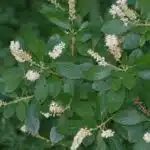Cherry laurel is one of the most beautiful shrubs to grace the outdoor landscape. Its verdant leaves, fragrant white flowers, and deep red fruit are like a lush carpet of nature’s own artwork. The cherry laurel is an easy-to-grow plant that can bring beauty and life to any garden or patio. If you have ever wanted to add this stunning shrub to your garden, then read on for all the information you need to know about how to grow and care for a cherry laurel.
As a botanist and gardener, I am passionate about the natural world and helping others cultivate their own little pieces of paradise at home. Growing a cherry laurel is an excellent way to add some of nature’s own beauty into your landscape while also making it easier for birds, bees, and other wildlife to thrive in your yard or garden. Here I will provide detailed instructions on how to successfully plant, grow, and care for these majestic plants so that you too can enjoy their beauty year round.
The best part about growing a cherry laurel is that it requires very little maintenance once established. With just a few simple steps, you can give your plant everything it needs for healthy growth without having to spend hours tending it each day. Whether you have years of gardening experience behind you or are just starting out with your first attempt at growing something from seed, this guide will provide all the necessary information needed for success!
What Is Cherry Laurel?
Cherry laurel (Prunus laurocerasus) is an evergreen shrub native to the Mediterranean and parts of Asia. It’s a popular ornamental plant that provides year-round interest with its glossy dark green foliage, fragrant white flowers, and black fruits. As a versatile shrub, it can be used as an informal hedge or accent planting in the garden. It’s even suitable for growing in containers, making it an ideal choice for balconies and patios.
Cherry laurel is a hardy plant that’s easy to look after. It thrives in most soil types and prefers full sun to part shade positions. Once established, it requires very little maintenance apart from occasional pruning to maintain its shape and size. As far as watering goes, cherry laurels need regular watering during hot dry periods but are otherwise quite drought tolerant once they’ve been given time to become established in their new environment.
With its attractive foliage, pretty flowers, and tolerance of various conditions, cherry laurel is an excellent addition to any landscape design whether planted as a specimen or incorporated into a group planting scheme. Its ability to cope with both sunny and shaded sites makes it a great choice for areas of your garden where other plants may not thrive so easily.
Where Does Cherry Laurel Grow?
Blooming with lush green foliage, the Cherry Laurel is a beautiful sight to behold. Like a beacon of hope and renewal, it’s the perfect addition to any garden. But for those wanting to grow their own, there are some essential pieces of knowledge to be aware of – starting with where it grows best.
When it comes to finding the ideal planting site for your Cherry Laurel, location is key. This versatile shrub thrives in full sun or partial shade and prefers moist, well-drained soil. It can tolerate a range of soils from acidic to neutral or even alkaline as long as they are not boggy or waterlogged during winter months. However, when in full sun exposure keep an eye out for leaf scorching and other symptoms of drought stress.
When planting your Cherry Laurel, there are several factors to consider such as aspect and wind protection. It’s wise to choose a sheltered spot to guard against harsh winds which can damage both foliage and stems. Also, aim for an area with good air circulation and plenty of space; this will give the plant plenty of room to spread its roots and grow big and strong!
So now you know how important choosing the right location is for cultivating your very own Cherry Laurel – let’s move on to selecting a suitable variety…
Choosing A Planting Site
Choosing the proper planting site for your cherry laurel is essential for successful growth. The key considerations are location, soil type, and sun exposure.
First, cherry laurel requires full to partial sun, with exposure to at least four hours of sunlight per day. It can tolerate shade but will not produce as many leaves and flowers in shady spots. The plant should also be planted in an area that will not be disturbed by digging or foot traffic; pick a spot that is out of the way to prevent damage to the roots.
When it comes to soil type, cherry laurel prefers well-drained soil with lots of organic matter. Be sure to test the pH level of your soil before planting and adjust it if necessary; ideal pH levels range from 5.5-7.0 for this species. Additionally, add compost or aged manure prior to planting for optimal growth conditions.
Thus, when selecting a planting site for your cherry laurel, look for an area with full or partial sun exposure and well-drained soil with a neutral pH level. With careful consideration and preparation of the site, you are sure to have success growing this beautiful shrub!
Soil Requirements
Choosing the right site and soil for planting a Cherry Laurel can make all the difference in its growth and health. Firstly, it is essential to select an appropriate location with good drainage, full sun or partial shade, and protection from strong winds. Secondly, soil requirements are equally as important to get right – Cherry Laurels do best in moist but well-drained soils of pH between 5.5 and 7.5 that are rich in organic matter and retain moisture without becoming waterlogged.
When considering the soil type for your Cherry Laurel:
- Aim for loams or sandy loams with a ratio of 40% sand to 60% silt plus clay.
- Incorporate plenty of organic matter such as compost or aged manure before planting to increase fertility, aeration, water retention, and drainage.
- Test the pH if you’re unsure – garden centers usually carry kits that you can use at home for this purpose.
For optimal growth conditions for your Cherry Laurel, remember these key points: select a site with adequate sunlight; choose soils that are rich in humus; ensure good drainage; test pH levels if necessary; incorporate organic matter prior to planting; and pay attention to moisture retention/waterlogging issues. With proper care and consideration of these foundations, you will be well on your way to growing a healthy Cherry Laurel tree!
Climate Considerations
Nature has a way of surprising us, as if it is a part of us. We find ourselves in awe when we see the cherry laurels blooming and standing tall. Knowing how to properly care for them can be quite the challenge, though. Climate considerations play an important role in doing so.
When looking at climate considerations, it is important to take into account the temperature range of the area in which you will be planting your cherry laurel. The optimal range is from 40-90 degrees Fahrenheit. As such, these plants are best suited for warmer climates, although they can still grow in cooler climates as long as there’s enough sunlight and water available. Additionally, if you’re planting in an area with heavy rainfall or strong winds, make sure to provide extra protection and shelter for your plants to avoid damage or stress on them.
It’s also crucial to note that cherry laurels prefer full sun but will tolerate some shade during hot periods. Keep in mind that too much shade can result in fewer blooms and less vibrant foliage, so consider this when planning where to plant them. If you live in a colder climate and want to ensure successful growth of your cherry laurel tree, you may want to look into using cold frames or mulch to help protect your plants during extreme weather conditions like frosts or snowstorms.
Taking all these factors into consideration before planting your cherry laurel tree will help ensure its optimal health and growth for years to come!
Planting Cherry Laurel
Planting Cherry Laurel is like planting a beautiful tapestry of color into your garden. As with any new addition, there are several important considerations that should be taken into account before you begin. Specialist in botany and gardening will tell you that, when it comes to selecting the best spot for your cherry laurel, sun exposure is key. Make sure that the area gets plenty of sunlight throughout the day; six or more hours is optimal. Additionally, if possible, try to choose a place that has some protection from strong winds; even though they can be quite hardy, they still need a bit of shelter from harsh gusts.
When it comes time to actually plant your cherry laurel, dig a hole slightly wider than the root-ball and about as deep as the root-ball itself. Place the root-ball in the hole and backfill it with soil mixed with organic matter such as compost or peat moss. Be sure to tamp down the soil around the roots once you have filled in the hole in order to ensure good contact between the roots and soil. Water your newly planted tree generously and mulch around its base with material such as wood chips or bark mulch – this will help keep moisture levels consistent.
With proper care, your cherry laurel can thrive for years to come! With its glossy foliage and fragrant blooms, it’s sure to be an eye-catching addition to any garden. Now that you’ve got your plant securely in place, all that’s left is to make sure it’s properly watered and fertilized – two essential steps on your path towards a lush garden oasis.
Watering And Fertilizing
Watering and fertilizing are essential components of growing a healthy cherry laurel. They need consistent moisture, especially during the first two years while they become established. During the dry summer months, deep watering at least once a week is recommended. Fertilizing should be done twice yearly with a general-purpose fertilizer that contains nitrogen, phosphorus, and potassium. This will help promote growth and greening of the foliage.
It’s important not to over-fertilize your cherry laurel as it can cause leaf burn or other damage. Overwatering can also be damaging since cherry laurels don’t tolerate wet soil conditions for extended periods of time. Be sure to monitor the soil moisture level to make sure it’s not over watered.
Cherry laurels are low maintenance plants when it comes to watering and fertilizing, but they do require regular attention in order to thrive. With proper care and attention, your cherry laurel should grow strong and healthy for many years to come. Now let’s look at how to prune your cherry laurel for optimal health and beauty!
Pruning Cherry Laurel
Pruning Cherry Laurel is an important step to ensure this shrub looks its best and thrives in your garden. Pruning should be done annually, and can include removing dead branches and trimming the plant back to shape it or keep it within bounds. This is typically done in late winter or early spring, just before new growth begins.
There are several methods of pruning that you should consider when pruning Cherry Laurel:
- Thinning: This involves removing thicker branches that cross over each other or rub against one another. Removing these branches will improve air circulation, reduce overcrowding, and reduce potential disease problems.
- Heading back: This is done by cutting back larger stems to a lateral branch or bud. Doing so will encourage branching and a denser overall shape to the shrub.
- Renewal pruning: For established plants that need rejuvenation, remove one third of the oldest stems at ground level each year for three years, then begin the cycle again as needed.
By taking these steps you can ensure your Cherry Laurel remains healthy and attractive throughout the year. With judicious pruning, you’ll also help control pests and diseases which we’ll discuss next.
Controlling Pests And Diseases
One of the main concerns for gardeners when growing cherry laurel is keeping pests and diseases at bay. It’s important to be vigilant and to immediately treat any sign of damage. Whilst most pests, such as aphids, can be managed with a strong spray of water, fungal diseases like leaf spot or powdery mildew need to be treated with a fungicide. For more serious cases, like root rot caused by Phytophthora species, it may be necessary to remove and destroy the affected plants.
In addition, it’s essential to keep the area around the laurel well-maintained. Remove any weeds or dead leaves that accumulate around the plant base as they can harbour disease. Furthermore, avoid excessive fertilizing which can lead to weak foliage susceptible to pest damage and disease.
Overall, by following these simple steps you should have healthy looking cherry laurels that will add beauty to your garden for many years to come. With regular monitoring and prompt action when needed, you can ensure you are getting the best out of your plants. Let’s now turn our attention towards propagating cherry laurels from cuttings…
Propagating Cherry Laurel
Propagating Cherry Laurel is a rewarding process for the experienced gardener. It is a simple, straightforward task that can help you create new Cherry Laurels to fill your garden with beautiful evergreen foliage. The following steps will guide you through the process of propagating from seed, cuttings, and layering:
• Seed propagation: Cherry Laurel seeds should be harvested in autumn when they have fully ripened. Place them on damp paper towels and keep them at room temperature until they germinate. • Cuttings: Take cuttings in early spring or late summer by taking off shoots that are 3–4 inches long. Make sure to remove all leaves except the top two pairs and dip them in rooting hormone before planting into a pot filled with moist soil. • Layering: This method involves bending low-growing branches to touch the ground and covering them with soil so they take root while still attached to the parent plant.
Propagating Cherry Laurels is a great way to expand your garden without having to buy more plants or wait for seeds to germinate. It is also an excellent choice for anyone looking for a sustainable gardening solution as it does not require any additional resources or materials beyond what you already have in your garden. With proper care and attention, you can quickly fill up your garden with healthy new specimens of this stunning evergreen shrub!
Companion Planting
Companion planting is a beautiful and beneficial way to nurture your cherry laurel. Like a mother embracing her children, you can create the perfect environment for your plants to thrive together. Here are three tips to consider when companion planting with cherry laurel:
- Plant cherry laurel in close proximity to other plants that require shade or protection from intense sun, such as rhododendrons or azaleas.
- Add herbs like lavender and thyme around the base of the plant to keep away pests and attract beneficial pollinators.
- Combine cherry laurel with other evergreen trees and shrubs, such as boxwood, holly, and magnolia, to create an interesting texture in the garden bed.
As a specialist in botany and gardening, I can tell you that following these steps will provide a healthy growing environment for your cherry laurel while also improving the overall appearance of your garden. By making thoughtful decisions about which plants you pair together, you’ll be able to ensure successful growth for all involved.
Using companion planting techniques also helps promote sustainability in our gardens, providing us with an opportunity to support nature’s balance within our own spaces. With this strategy, we can help ensure that our gardens remain vibrant for years to come! Next up is exploring how we can make use of our cherry laurels…
Uses Of Cherry Laurel
Cherry laurel is an attractive evergreen shrub that can be found in many gardens. Its uses are as plentiful as its aesthetic appeal. It’s a great choice for privacy hedges, borders, or foundation plantings. Additionally, it has many medicinal and culinary applications.
In terms of medicinal use, cherry laurel is known to have antispasmodic properties which can be used to treat stomach cramps and other digestive issues. Its leaves contain prussic acid which can be used topically to ease pain from bruises, sprains, and strains. It can also be used to make a tea for treating colds and flus or even brewed into a tincture for helping with anxiety or depression.
Cherry laurel also has many culinary uses. The leaves can be used as a flavoring agent in dishes like sauces, stews, soups, salads, and marinades; while the flowers can be candied and eaten as a sweet treat on their own or added to desserts like cakes and cookies. This versatile shrub is even used to make liqueurs such as the popular German beverage called Kirschwasser!
No matter what your needs may be – whether for its medicinal or culinary value – cherry laurel is sure to fit the bill. With its hardy nature and simple care requirements, this shrub makes an ideal addition to any garden!
Popular Varieties Of Cherry Laurel
There are a number of popular varieties of cherry laurel that can be grown in the garden. For those looking for a hardy, evergreen shrub with attractive foliage and flowers, then these varieties may fit the bill. Prunus laurocerasus is an evergreen shrub which is known for its glossy leaves and fragrant white flowers – it’s a great choice for low-maintenance landscaping. Other varieties such as ‘Schipkaensis’ or ‘Otto Luyken’ offer more compact growth, while ‘Rotundifolia’ is ideal for hedging.
No matter which variety you choose, there are some basic growing requirements that will help ensure success. Cherry laurels require full sun to partial shade and well-drained soil with plenty of organic matter; they will also thrive in acidic soils. Regular watering is necessary during hot or dry weather conditions, making sure to keep the soil evenly moist. Pruning should be done at the end of spring or beginning of summer to maintain shape and encourage new foliage growth.
When it comes to pests and diseases, cherry laurels are relatively disease resistant but can sometimes be affected by aphids or scale insects. Keep an eye out for yellowing leaves which could indicate a nutrient deficiency; if this occurs then apply a balanced fertilizer according to package directions. With proper care and attention, cherry laurels can provide beautiful evergreen foliage year round — perfect for creating that lush landscape effect!
Troubleshooting Common Problems
Cherry laurel, also known as Prunus laurocerasus, is a stunning ornamental shrub, popular for its dense foliage and fragrant white flowers. Growing this plant can be a rewarding experience; however, it also has its challenges. Let’s take a look at some of the common problems you may encounter while growing cherry laurel.
The most common issue encountered while growing cherry laurel is leaf spot disease. This fungal infection is caused by meteorological conditions that favor fungal growth and can manifest in spots on the leaves or branches of the plant. To combat this problem, it is important to ensure that your cherry laurels are planted in well-draining soil and free of debris. Additionally, regular pruning will help reduce overcrowding and humidity levels near the plant which helps prevent fungal growth.
Another issue with cherry laurel is root rot, typically caused by too much water or poor drainage around the roots of the plant. This can be avoided by planting in sandy soil and avoiding overwatering during periods of heavy rainfall and hot weather. Applying a balanced fertilizer once every two months will also help promote strong root health and keep your plants looking their best!
In addition to these issues, it’s important to monitor your plants for signs of pests such as aphids or scale insects which can cause damage to the foliage or bark if left untreated. Taking preventative measures such as using insecticidal soap or horticultural oil treatments to control infestations can help keep your plants healthy and thriving for years to come!
Harvesting And Storing Cherry Laurel
Harvesting and storing Cherry Laurel is a simple process that can be done with relative ease. While the plant’s fruit can take up to two years to mature, once it does, the harvesting process can begin. It is important for gardeners to note the timing of their harvest as it can have an impact on the flavor of the fruits. The best time to harvest is when the fruits are fully ripe but before they start to rot or deteriorate in any way. Once harvested, the fruit should be stored in a cool, dry place as soon as possible.
One of the benefits of harvesting and storing Cherry Laurel is that it can be used all year round. The fruit can be used fresh or frozen for later use. Gardeners may choose to dry out some of their harvest so that it can be used in cooking or baking recipes throughout the year. For those wishing to store their harvest longer term, freezing is one of the most reliable methods and will help keep them fresh and flavorful for months at a time.
It’s important for gardeners to remember that while harvesting and storing Cherry Laurel may seem like a straightforward task, there are certain steps they must take in order to ensure optimal results. Following best practices such as harvesting only at peak ripeness and ensuring proper storage conditions will ensure maximum flavor and quality from your harvested fruits for many months to come.
Frequently Asked Questions
What Is The Best Time Of Year To Plant Cherry Laurel?
Have you ever thought about planting a cherry laurel? You may be wondering when the best time of year to plant one is. As a specialist in botany and gardening, I can tell you that the ideal time to plant your cherry laurel is:
• In early spring when temperatures are mild • When rainfall is plentiful • Before new growth begins on the tree • When the soil is still moist from winter rains
These are all important factors for ensuring your cherry laurel will thrive. Planting at this time of year helps to ensure that there’s plenty of moisture available for your tree as it becomes established. Plus, it gives your tree enough time to develop strong roots before winter comes around again.
By following these steps, you can give your cherry laurel the best chance of success. It’s also essential to provide adequate water and sunlight for your tree each day and to keep an eye out for pests or disease. With proper care, your cherry laurel will soon become a beautiful addition to your landscape!
How Long Does It Take For Cherry Laurel To Mature?
Do you ever wonder how long it takes for the gorgeous cherry laurel shrub to mature? Growing and caring for this stunning plant is not a difficult task, but understanding its growth rate is key to ensuring its success. As a botany and gardening specialist, I’m here to shed some light on what you need to know about the maturation of cherry laurel!
First off, it’s important to note that cherry laurel plants take anywhere from three to five years before they reach their full potential. The maturation process can vary depending on factors like sunlight, water availability, and soil quality. Additionally, if you start with a small seedling then it will take longer than if you begin with a more mature plant.
When planting your cherry laurel, make sure to choose an area that receives plenty of sunlight throughout the day as well as watering regularly in order maintain optimal growth conditions. It’s also important to provide adequate drainage so that the roots don’t become waterlogged or susceptible to root rot. Be sure to apply mulch around the base of the plant in order to help keep moisture levels consistent. Additionally, it’s beneficial to provide your cherry laurel with regular feedings of an organic fertilizer throughout its growing season as this will promote strong new growth.
As your cherry laurel grows over time, be sure to prune any dead or diseased branches in order to encourage healthy new growth and shape the shrub into desired form. With patience and proper care, your beautiful cherry laurel will eventually reach its full potential in no time!
Are There Any Diseases Or Pests Specific To Cherry Laurel?
No gardener likes to hear about diseases or pests, but it is inevitable that we must consider them in our gardening projects. As the old adage goes, “An ounce of prevention is worth a pound of cure” and this rings true for cherry laurels as well. As an experienced botanist and gardener, I can attest to the fact that cherry laurel plants have a few specific ailments that may be encountered.
The most common disease associated with cherry laurels is Phytophthora root rot, which is caused by a fungus in the soil. Symptoms include wilted leaves, discolored foliage and stunted growth. To prevent this disease, ensure that your soil has adequate drainage and avoid overwatering your plant. Additionally, fertilize your plant with a balanced fertilizer to promote healthy growth.
Pests are also a potential issue when growing cherry laurel plants. Aphids may feed on the plant’s sap and can cause yellowing of foliage or distorted leaves if left untreated. For small infestations you can use insecticidal soap or neem oil to remove them from the plant. If you notice any signs of pests on your cherry laurel, inspect it closely for bugs before treating it with an appropriate product.
To keep your cherry laurel healthy and looking its best, practice good garden hygiene by removing dead leaves and debris from around the base of the plant regularly. Regular pruning will help encourage dense foliage and discourage pests from settling in too long on your plant!
How Often Should I Water My Cherry Laurel?
Watering is an important part of cherry laurel care. It’s important to ensure that the soil around the plant is kept moist but not soggy. During active growing periods, usually in spring and summer, your cherry laurel should be watered deeply every 7-10 days. In the colder months, you can reduce your watering frequency to once every 3-4 weeks or when the top layer of soil feels dry. However, if your plant is planted in a pot or container then it will need more frequent watering than if it were in the ground.
It’s also important to monitor the water levels of your cherry laurel as too much or too little water can cause leaf drop and other unhealthy signs. The best way to tell if your plant needs more water is to check the soil. If it feels dry up to 2 inches below the surface, then it’s time for a drink! You can also check for wilting leaves which could mean that your plant needs more water.
Overall, proper watering is essential for healthy growth and longevity of your cherry laurel shrub. Make sure you are properly monitoring moisture levels and adjusting based on seasonal temperatures and rainfall amounts. With some regular TLC, you’ll have a beautiful shrub that will flourish for many years to come!
How Much Sun Does Cherry Laurel Need?
Cherry laurel (Prunus laurocerasus) is a great choice for gardeners seeking an evergreen shrub that is low-maintenance and can tolerate both sun and shade. For example, planted in the right spot, a cherry laurel can offer a homeowner screening and privacy from the street or neighbors year-round. When it comes to how much sun does cherry laurel need, there are some ranges of acceptable light conditions:
- Partial shade: Cherry laurel can do well when planted in partial shade – that is, 6 hours of direct sunlight or more.
- Full sun: If you give your cherry laurel plenty of space to spread out, it can also tolerate full sun.
- Total shade: It may not flower as often, but cherry laurels will still thrive in total shade with no direct sun exposure.
- Too much sun: In hot climates like Arizona or California, however, too much direct sunlight may scorch your cherry laurel’s leaves, so be sure to provide adequate protection from the afternoon heat.
For gardeners who have limited space, this makes the cherry laurel an ideal choice since it can grow happily in nearly any kind of light exposure. Additionally, they require minimal pruning and only need water once or twice a week during drought periods. To ensure optimal health and growth of your cherry laurel plantings, however, be sure to select a location that offers at least partial shade throughout the day. With proper care and attention given to its particular light requirements, you’ll be rewarded with beautiful foliage and fragrant white flowers all year round!
Conclusion
As a specialist in botany and gardening, I can say with confidence that Cherry Laurel is an excellent choice for any garden. Not only is it a beautiful and hardy plant, but with proper care and attention, it can last for many years. It typically takes two to three years for the shrub to mature, and once it does, it will be a stunning addition to your outdoor space.
In terms of maintenance and care, Cherry Laurel requires regular watering during periods of drought and should be planted in areas with plenty of sun exposure. Additionally, you’ll want to watch out for common pests such as scale insects or powdery mildew. With the right amount of love and attention, your Cherry Laurels will thrive!
One interesting statistic about this species is that it has been used as an ornamental bush in gardens around the world since Greek mythology. That’s over 2500 years of horticultural admiration! With proper planting, pruning, and watering practices, you too can enjoy its beauty season after season.





























